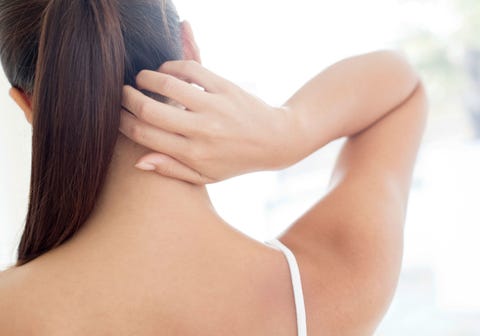Losing your hair can be incredibly difficult. But how do you know when it's normal shedding or something more serious?
We asked trichologist Wil Fleeson, owner of Rainbow Room International and Director of Trichology Scotland, to decode the different types of female hair loss and explain what to look out for with each.
1. Diffuse hair loss [aka Telogen Effluvium]
This is the general thinning of hair all over the scalp, rather than in one particular area.
What causes it?
The causes vary, but this type of hair loss can usually be put down to a lack of certain vitamins, or stress. "Certain vitamins and minerals are crucial for healthy hair," says Fleeson. "These are iron, ferritin, zinc, vitamin B12, vitamin D3 and calcium, so if you're experiencing thinning, it could be your diet that's the culprit." Stress is also a big trigger. "Stress depletes the supply of blood to the hair follicles, which can cause hair to stop growing," explains Fleeson.
Is it treatable?
Yes, but first, you need to get to the bottom of the issue. "As hair grows from the inside out, the only way to treat this type of hair loss is to find the root cause," says Fleeson. If you think it's due to a deficiency, having a full blood test is a vital first step. "If you're prone to conditions like anaemia, your GP might suggest taking targeted vitamin supplements or adjusting your diet," he adds.
Alternatively, regular exercise, therapy and meditation can all help if you suspect your hair loss is stress-induced. "Making sure to take time out to relax and look after yourself can be hugely beneficial – especially as this type of hair loss can be reversible," says Fleeson.

2. Female pattern hair loss [aka Androgenic Alopecia]
This is a widening of the parting, often coupled with the general thinning of the crown.
What causes it?
Androgenic alopecia is caused by an hormonal imbalance. It can also be genetic. "Hormonal imbalances are often triggered by events such as menopause or pregnancy," Fleeson explains. During menopause, the levels of oestrogen and progesterone in the body drop, meaning hair grows more slowly and becomes thinner. "Oestrogen promotes the growth phase of the hair cycle while progesterone promotes the regeneration of the hair follicle," Fleeson elaborates.
When you're pregnant, hormonal changes mean that more hair follicles enter the growth phase than normal. Two to three months after childbirth, the normal hair cycle returns, causing excessive shedding to occur, although this is normally only temporary.
Is it treatable?
Minoxidil, the only FDA-approved treatment for female pattern hair loss, is often prescribed for this type of thinning. It's applied directly to the scalp and works by increasing the blood supply to stimulate hair growth and prevent hair follicles from shrinking. But there are newer treatments emerging, too. "Hormonal balancing treatments are now being used, such as BHRT (Bioidentical Hormone Replacement Therapy) to boost oestrogen and progesterone levels," says Fleeson. "However, there is no conclusive evidence as of yet that these treatments are always successful."
For a treatment you can do at home, look to Nioxin. This specialist haircare brand helps tackle the issue of hormonal hair loss by offering fully tailored 3D System solutions that support scalp and hair health, promoting fuller-looking locks. Use their salon finder to find your local stockist.

3. Thyroid-related thinningThis is a uniform thinning of hair across the entire scalp. It can also affect hair texture, making it dry and coarse or extra soft and fine.
What causes it?
This type of thinning is most commonly linked with a condition called hypothyroidism. "This is where the thyroid is struggling to produce enough thyroxine," explains Fleeson. "This type of hormonal imbalance can lead to the thinning of the hair." The thyroid also helps to control your metabolism – if you have an underactive thyroid then the body is not converting food into energy as it should, which can result in the hair follicles either shutting down or slowing the growth of new hair.
Is it treatable?
If you think your hair loss may be a result of a thyroid disorder, the first thing to do is consult your GP or a qualified trichologist who will then be able to determine an appropriate course of treatment. "Successful treatment of thyroid-related thinning often comes with successful management of hypothyroidism using thyroxine," says Fleeson. "Once the thyroxine levels stabilise, so often does the density of the hair."
In the meantime, if your hair has become fine and brittle due to the above, there are things you can do to help it look fuller and healthier. Nioxin's 3D Intensive Diaboost treatment helps create the feeling of thicker, denser hair, as well as offering ongoing protection against breakage.
For fuller, thicker hair, try Nioxin's 3D Care System range and take the 30-day challenge to achieve a #fullerhairfullerlife. Visit the Nioxin website for more information or to find your local salon
Healthcare professionals quoted in this article do not endorse Nioxin or any other brands
No comments:
Post a Comment